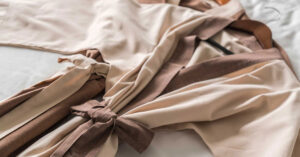Is Mesh Better Than Wool for Lining Fabric?
Fabric compatibility is crucial in fashion and sewing, influencing the quality and longevity of garments. When it comes to lining, choosing the right fabric can make or break a design. This article explores the compatibility of mesh and wool for lining, examining their characteristics and offering insights into their potential use together.
Compatibility Analysis
Yes, mesh and wool can be combined effectively for lining, but with some considerations. Mesh is lightweight and breathable, making it suitable for enhancing the comfort of wool garments, which are warm and durable. However, factors such as texture, weight, stretch, care requirements, and durability must be carefully considered.
Key Factors
- Texture: Mesh is smooth and airy, while wool is textured and dense. Their contrasting textures can add visual interest but may require careful handling to avoid pilling.
- Weight: Mesh is lightweight, complementing the heavier nature of wool. This balance can improve the overall drape of garments.
- Stretch: Mesh often has some stretch, whereas wool typically does not. This difference may require special sewing techniques to ensure a good fit.
- Care Requirements: Wool needs gentle care, often requiring dry cleaning, while mesh can typically be machine washed. This disparity requires thoughtful garment care planning.
- Durability: Wool is known for its durability, while mesh is more delicate. Reinforcement at stress points can help maintain the integrity of the garment.
Fabric Properties Comparison Table
| Property | Mesh | Wool |
|---|---|---|
| Fiber Content | Synthetic | Natural |
| Weight & Thickness | Lightweight | Medium to Heavy |
| Breathability | High | Moderate |
| Moisture-Wicking | High | Moderate |
| Stretch & Elasticity | Moderate | Low |
| Wrinkle Resistance | High | Moderate |
| Care Instructions | Machine wash, low temp | Dry clean or hand wash |
| Durability | Moderate | High |
Benefits of Mixing These Fabrics
- Enhanced Texture and Visual Interest: The combination of mesh and wool can create a unique texture, adding depth to designs.
- Improved Comfort and Performance: Mesh lining can enhance breathability and comfort in wool garments, making them suitable for a wider range of temperatures.
- Better Drape and Movement: The lightweight nature of mesh can complement wool’s structure, improving drape and movement.
- Cost-Effectiveness: Using mesh as a lining can be a cost-effective way to add functionality without significantly increasing material costs.
- Seasonal Versatility: This combination can make garments suitable for transitional weather, providing warmth without overheating.
- Design Possibilities: The contrast between mesh and wool opens up creative design opportunities, from casual wear to more formal attire.
Potential Challenges
- Different Shrinkage Rates: Wool may shrink more than mesh, requiring pre-treatment of fabrics.
- Conflicting Care Requirements: Differing care instructions can complicate maintenance.
- Texture Clash or Pilling: The smoothness of mesh against wool can cause pilling if not handled properly.
- Seam Puckering: Different fabric weights may cause puckering at seams, necessitating careful sewing techniques.
- Color Bleeding or Fading: Wool dyes may bleed onto mesh, especially in dark colors.
Practical Solutions
- Pre-wash both fabrics separately to minimize shrinkage issues.
- Use a gentle cycle or hand wash to accommodate both fabrics.
- Employ interfacing or stabilizers to manage seam puckering.
- Test for colorfastness before combining fabrics.
Sewing & Styling Tips
- Sewing Techniques: Use a ballpoint needle and polyester thread for mesh, and a universal needle for wool. Adjust tension settings accordingly.
- Interfacing Needs: Lightweight interfacing can stabilize seams without adding bulk.
- Seam Finishing: Consider French seams or serging to prevent fraying.
- Pattern Selection: Choose patterns that accommodate the stretch of mesh and the structure of wool.
- Styling Ideas: Pair mesh-lined wool jackets with casual or business attire for a versatile look. Use in home decor for stylish yet functional throws or cushions.
Care & Maintenance Guide
- Washing Instructions: Hand wash or use a gentle cycle with cold water. Avoid wringing out the fabric.
- Drying Recommendations: Lay flat to dry to maintain shape and prevent stretching.
- Ironing and Steaming Tips: Use a low heat setting and a pressing cloth to protect both fabrics.
- Stain Removal: Treat stains promptly with a gentle detergent.
- Long-term Care: Store garments in a cool, dry place to prevent moth damage to wool.
FAQ Section
-
Can you wash mesh and wool together?
It’s best to wash them separately due to different care needs. -
Will wool shrink more than mesh?
Yes, wool is more prone to shrinkage, so pre-washing is advised. -
What needle size should I use for sewing these fabrics together?
Use a size 70/10 ballpoint needle for mesh and a 80/12 universal needle for wool. -
Can you mix mesh and wool in one garment?
Absolutely, but consider the care and structural differences. -
How do you prevent pilling when combining these fabrics?
Use a gentle wash cycle and avoid friction during wear. -
Is it okay to mix mesh and wool for upholstery?
It’s possible, but wool’s durability makes it more suitable for heavy use. -
What’s the best way to finish seams with these fabrics?
French seams or serging provide a clean finish and prevent fraying.
By understanding the properties and potential challenges of mixing mesh and wool, you can create garments that are both stylish and functional. With careful planning and execution, these fabrics can work together beautifully in a variety of applications.

Leave a Reply